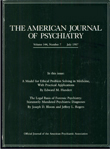Economic reforms and the acute inpatient care of patients with schizophrenia: the Chinese experience
Abstract
OBJECTIVE: This study compared insured and uninsured schizophrenic inpatients in China and examined changes in the acute inpatient care of schizophrenic patients during China's economic reform era. METHOD: Detailed chart reviews of 50 randomly selected inpatients discharged from a hospital in central China each year from 1984 through 1993 identified 321 patients with schizophrenia. Demographic, insurance, treatment, and cost data of these patients were collected from the charts. RESULTS: With logistic regression models to control for confounding variables, the analyses showed that the 129 insured patients were significantly more likely than the 192 uninsured patients to be urban residents, to be older, to have had 7 or more years of schooling, and to have had more psychiatric hospitalizations; moreover, their index admissions were longer and were more likely to include use of traditional Chinese medications. The estimated 19% of schizophrenic individuals in the community with health insurance receive inpatient treatment 2.8 times more frequently than the 81% without insurance. Compared to admissions in 1984-1988, admissions in 1989-1993 were significantly shorter and involved longer periods of polypharmacy with multiple antipsychotic medications but included lower mean chlorpromazine-equivalent doses of medication. The relative cost of inpatient care for an acute episode of schizophrenia increased 3.5-fold over the 10-year period, from 11% of mean annual household income in 1984 to 37% in 1993. CONCLUSIONS: Changes in the incentive system for care providers and rapid increases in the cost of care during the economic reform era have resulted in increasingly restricted availability of services for the many schizophrenic patients without health insurance.



